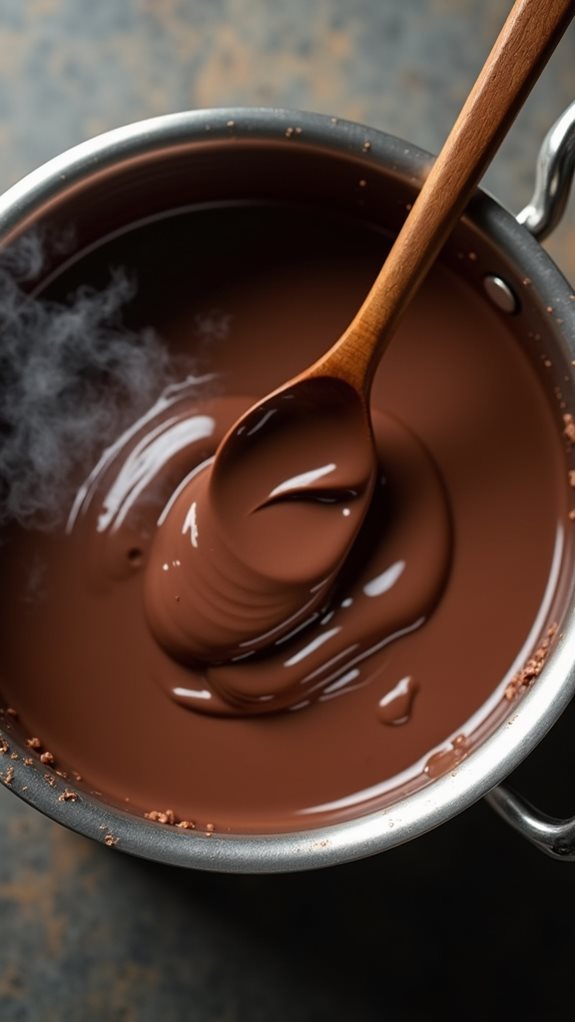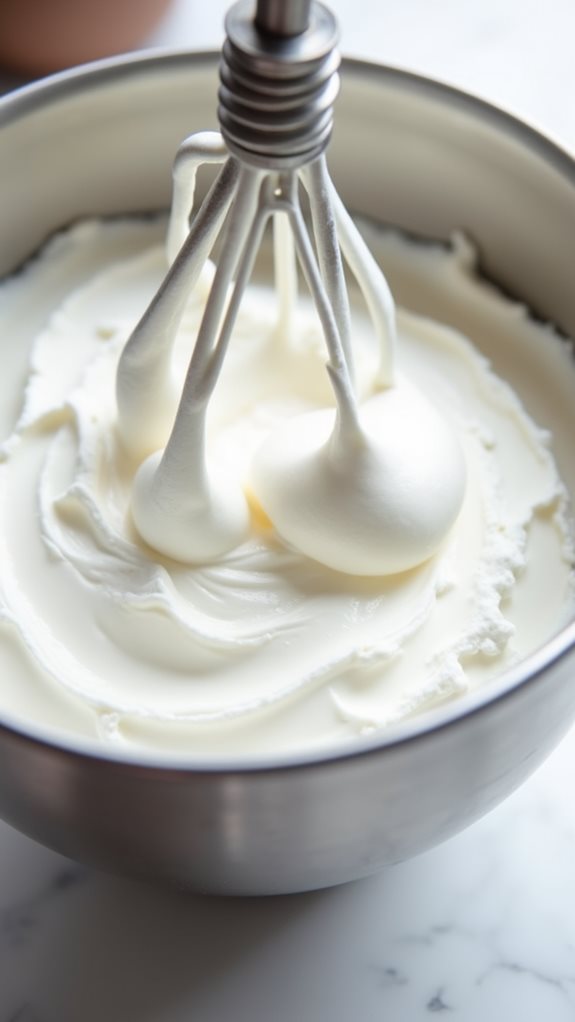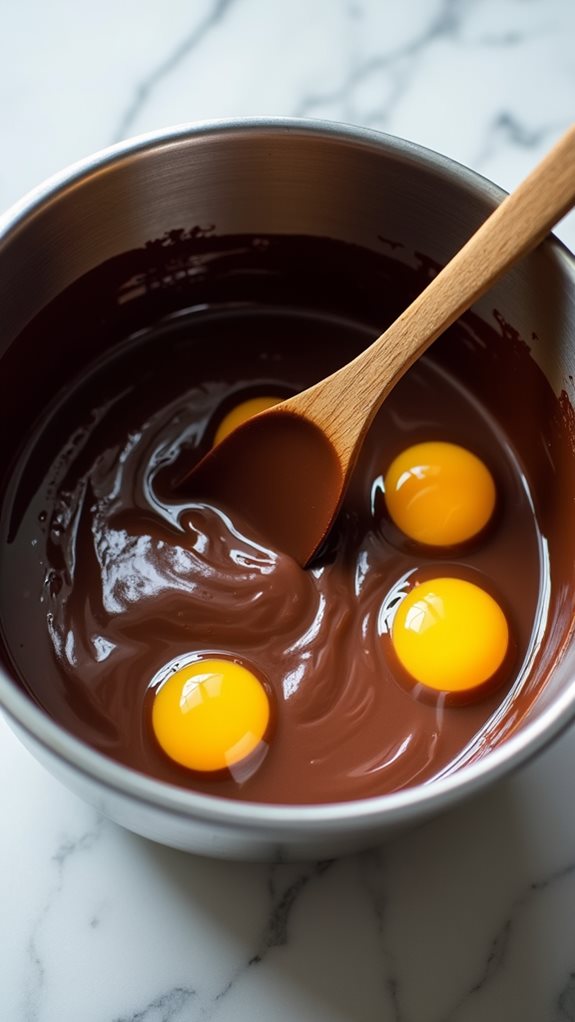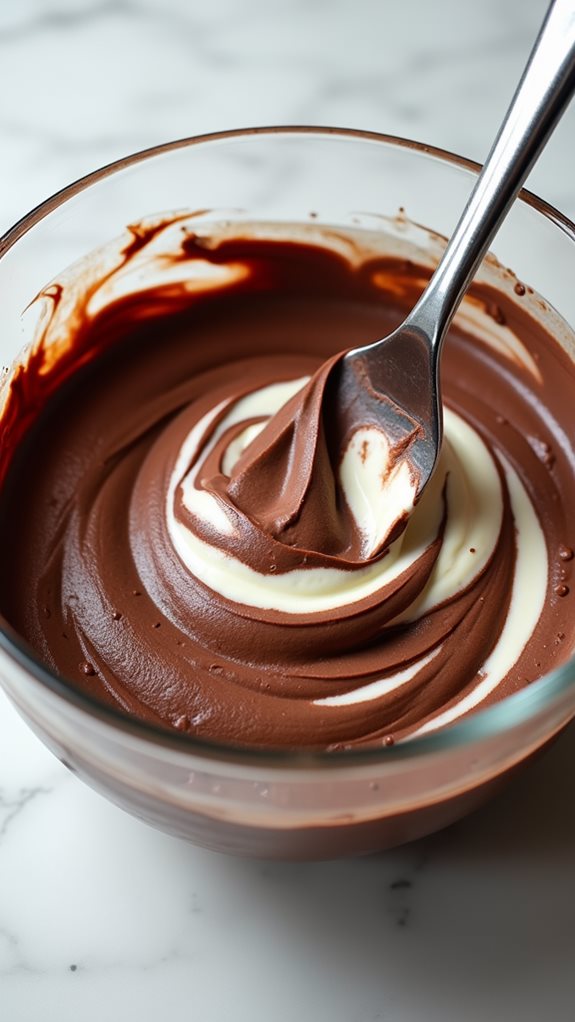You might be surprised to learn that chocolate mousse wasn't always the refined dessert we know today—it began as a savory dish in 18th century France, where chefs would whip various meats into a foam-like consistency. It wasn't until the 1800s that French culinary masters transformed this technique into the silky chocolate dessert that's now served in restaurants worldwide. While the basic recipe seems straightforward, mastering the perfect chocolate mousse requires understanding specific techniques and temperatures that can make the difference between a light, luxurious dessert and a dense, grainy disappointment. Let's explore what makes this classic French creation so uniquely challenging yet rewarding.
Key Takeaways
- Chocolate mousse is a classic French dessert made with dark chocolate, whipped cream, and egg whites for a light, airy texture.
- The main ingredients are 7 oz dark chocolate (70% cocoa), 1½ cups heavy cream, 3 eggs (separated), and ¼ cup sugar.
- Proper technique involves melting chocolate, whipping cream, beating egg whites, and gently folding ingredients to maintain airiness.
- The dessert can be prepared up to 24 hours ahead and requires careful temperature control throughout preparation.
- The final mousse should be light and billowy with a uniform color, showing ribbons that slowly disappear when folded.
History
Chocolate mousse dates back to the early 1800s in France, where chefs first whipped up this decadent dessert in prestigious Parisian kitchens.
You'll find that the word "mousse" itself comes from the French word meaning "foam" or "froth," perfectly describing this airy creation's texture. During this period, French culinary artists were experimenting with new techniques to incorporate air into chocolate preparations.
As you explore the dessert's evolution, you'll discover that it gained widespread popularity in the late 19th century when chocolate became more readily available to the public.
The first recorded chocolate mousse recipe appeared in a French cookbook in 1892, though earlier versions had been prepared in restaurants.
You'll notice that while the basic technique hasn't changed much since then, chefs have introduced countless variations.
The dessert's popularity soared in America during the 1960s when Julia Child featured it on her cooking show, introducing millions of home cooks to this French classic.
Today, you'll find chocolate mousse on menus worldwide, from casual bistros to Michelin-starred restaurants, proving its enduring appeal across generations.
Recipe
Classic French chocolate mousse is a luxurious dessert that transforms simple ingredients into an ethereal, velvety confection. The key to its renowned texture lies in the careful incorporation of air through whipped cream and egg whites, while rich dark chocolate provides an indulgent base.
This recipe strikes the perfect balance between simplicity and sophistication, requiring just five ingredients to create a restaurant-quality dessert. The technique focuses on proper temperature control and gentle folding methods to achieve the characteristic light, airy texture that has made chocolate mousse a timeless favorite.
- Dark chocolate (70% cocoa) – 7 oz (200g)
- Heavy whipping cream – 1½ cups (350ml)
- Large eggs – 3, separated
- Granulated sugar – ¼ cup (50g)
- Salt – ⅛ teaspoon
Begin by melting the chocolate in a double boiler until smooth, then allow it to cool slightly. Meanwhile, whip the cold heavy cream until stiff peaks form and set aside.
In a separate bowl, beat egg whites with salt until foamy, gradually add sugar, and continue beating until stiff peaks form. Stir the egg yolks into the cooled chocolate mixture until well combined.
Gently fold the whipped cream into the chocolate mixture using a spatula, then carefully fold in the beaten egg whites in three portions. Pour the finished mousse into serving glasses and refrigerate for at least 4 hours or overnight.
For optimal results, ensure all ingredients except the heavy cream are at room temperature before beginning. If the chocolate seizes during melting, add a tablespoon of warm heavy cream to smooth it out.
When folding the whipped cream and egg whites, use a gentle touch and move the spatula in a figure-eight motion to preserve the air bubbles that create the mousse's signature texture. The mousse can be prepared up to 24 hours in advance and kept refrigerated until serving.
Cooking Steps
You'll begin making chocolate mousse by melting your chocolate in a double boiler until it's completely smooth and silky.
Then separately whipping cold cream until stiff peaks form and beating egg whites with sugar until they're glossy and firm.
Next, you'll combine the melted chocolate with egg yolks until well blended, creating a rich base for your mousse.
Finally, you'll carefully fold in the whipped cream followed by the sweetened egg whites in three portions, using gentle, deliberate motions to preserve the air bubbles that will give your mousse its characteristic light texture.
Step 1. Melt Chocolate Until Silky

In a double boiler, start melting the chopped dark chocolate over gently simmering water, making sure the bottom of the bowl doesn't touch the water's surface. Stir occasionally with a rubber spatula, and you'll notice the chocolate beginning to transform from solid pieces into a glossy liquid. This process typically takes about 5-7 minutes, depending on your chocolate's size and temperature.
Watch the chocolate carefully as it melts, and don't let any water droplets fall into the bowl, as even a tiny amount can cause your chocolate to seize and become grainy. If you're working with high-quality dark chocolate, you'll see it develop a beautiful sheen as it reaches the proper temperature of around 115°F (46°C).
Once the chocolate is completely melted and smooth, remove it from the heat but leave it in the bowl over the warm water to maintain its silky consistency while you prepare the other ingredients. If you notice the chocolate becoming too thick, stir in a tablespoon of warm heavy cream to achieve the perfect consistency for folding into your mousse mixture.
Step 2. Whip Cream Until Peaks Form

Starting with perfectly chilled heavy cream is essential for achieving the ideal whipped texture. For best results, you'll want to chill your mixing bowl and whisk attachments in the freezer for at least 15 minutes before beginning, as cold equipment helps maintain the cream's temperature throughout the whipping process.
Pour the cold heavy cream into your chilled bowl and begin whipping at medium speed. You'll notice the cream starting to thicken after about a minute, but don't stop there.
Continue whipping while watching for changes in consistency – the cream will progress from loose and liquid to soft peaks, where the cream forms gentle mounds that slowly collapse.
Keep whipping until you achieve stiff peaks, where the cream stands firmly upright when you lift the whisk. At this stage, the peaks will hold their shape without falling over, and the cream will have a rich, luxurious texture that's perfect for folding into your chocolate mousse.
Be careful not to over-whip, as the cream can quickly turn grainy and begin to separate into butter.
Step 3. Beat Eggs With Sugar

With the whipped cream ready and set aside, the next step focuses on properly beating the eggs with sugar.
You'll need to separate your eggs carefully, placing the whites in a clean, dry bowl and setting the yolks aside for later use. Add the ⅛ teaspoon of salt to the egg whites, as this will help stabilize them during beating.
Using an electric mixer at medium speed, beat the egg whites until they become foamy and start to increase in volume. Once you've reached this stage, begin gradually adding the ¼ cup of sugar while continuing to beat the mixture.
You'll want to add the sugar slowly, about a tablespoon at a time, which allows it to incorporate properly without deflating the whites. Continue beating until you achieve stiff, glossy peaks – you'll know you're there when the mixture holds its shape and appears shiny.
To test for stiff peaks, lift your beater straight up; the peaks should stand straight without flopping over. If they're still soft or curl at the tips, continue beating for another minute or so until they're properly stiff.
Step 4. Combine Chocolate With Yolks

The crucial step of combining chocolate with egg yolks requires careful attention to temperature and timing. Before you begin, ensure your melted chocolate has cooled enough that it won't scramble the yolks, but remains fluid enough to blend smoothly. You'll know it's ready when you can comfortably hold your finger in the chocolate for several seconds without discomfort.
Take your room-temperature egg yolks and add them one at a time to the chocolate mixture, stirring vigorously after each addition until fully incorporated. You'll notice the mixture becoming slightly thicker and taking on a silky sheen.
If you find that your chocolate begins to stiffen or appear grainy, don't panic – simply stir in a tablespoon of warm heavy cream to restore its smooth consistency. The resulting mixture should be completely uniform, without any streaks of yellow from the yolks or unblended chocolate pieces.
This combination creates the rich foundation for your mousse, providing both structure and that characteristic dense chocolate flavor that will contrast beautifully with the light, airy texture you'll achieve in the following steps.
Step 5. Fold Mixtures Together Gently

Folding together your three prepared mixtures demands a delicate touch and proper sequence to achieve that perfect mousse texture.
Begin by taking your chocolate-yolk mixture and adding one-third of the whipped cream, using a rubber spatula to fold it in with broad, gentle strokes that sweep from the bottom of the bowl upward and over the top. Once that's incorporated, add the remaining whipped cream in two more additions, maintaining the same careful folding motion.
Now comes the most crucial step – incorporating the egg whites. Add them in three separate portions, using your spatula to cut through the center of the mixture and fold outward with a light hand.
You'll notice the mixture becoming progressively lighter and more airy with each addition. Continue folding just until you no longer see streaks of white; overmixing at this stage will deflate your mousse. The final texture should be uniform in color but still feel light and billowy.
When you're lifting the spatula through the mixture, it should leave ribbons that slowly disappear back into the surface, indicating you've achieved the perfect consistency.
Final Thoughts
Mastering chocolate mousse requires patience and attention to detail, but you'll find the results deeply rewarding. When you've followed each step carefully, you'll create a dessert that perfectly balances rich chocolate flavor with a cloud-like texture that's sure to impress your guests.
Remember that temperature control plays a crucial role in your success, so don't rush the process of melting and cooling the chocolate. If you're making this dessert for a special occasion, you can prepare it up to 24 hours in advance, which makes entertaining easier.
While the recipe may seem challenging at first, you'll develop a better feel for the proper techniques with each attempt. Don't be discouraged if your first try isn't perfect – even experienced chefs sometimes struggle with achieving the ideal consistency.
Focus on maintaining gentle folding techniques and proper temperature control, as these are the key factors that influence your final result. With practice, you'll soon master this classic French dessert and add an elegant, crowd-pleasing option to your culinary repertoire.















